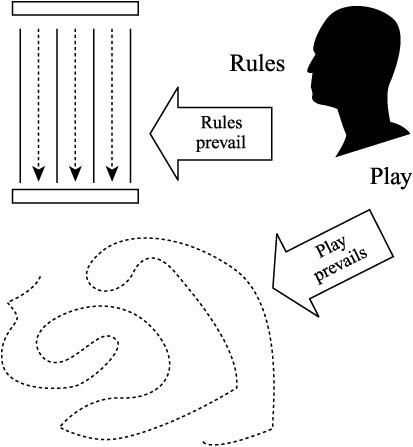Places for Games
Some games are matters of play. Others are matters of rules. Most are mixtures of both. A game that is wholly defined by play might not have goals or ways of winning. It might be something akin to an ongoing conversation in which the objective is one of just continuing to converse.
Rules strictly regulate other games, to the point that there seems to be almost no play at all. The focus of such games is on winning. The play is often reduced to the exercise of meticulously planned strategies.
Figure 1.1 provides a simple rendition of these notions. A game is a context in which you can explore play or rules. It can work in any number of ways. Games are endless. Some people play games to figure out rules. Others play games to apply rules. Still others play to defy rules.
Figure 1.1. Games involve rules and play.

When you deal with math as a conversation, it becomes a game that you can play in many ways. The rules can become secondary. The play can become secondary. Carrying on the conversation becomes an activity of making things up as you go along.
How is this possible? It is possible in the same way that a coffee shop or a shaded spot on a sidewalk becomes a place in which people carry on conversations. Such conversations emerge from the daily activity of life. They emerge because they do not require you to do anything other than what you are doing.
The notion that conversation can simply spring to life in any given setting is in part one of the reasons that this book presents its topics in an essential, randomized way. The essential presentation eschews “word problems.” While word problems are tremendously important and are hardly ever left out of standard math textbooks, in this context they are left out so that when you decide to flick to a page and begin a conversation, you can do so immediately.
This is a book of beginnings. It seeks no end other than providing the most direct possible inroad to a few starting points in your exploration of math. It leaves out much more than it includes. It avoids systematic learning. It strives instead to be analogous to a shaded place on a sidewalk or a table in a cafe.
